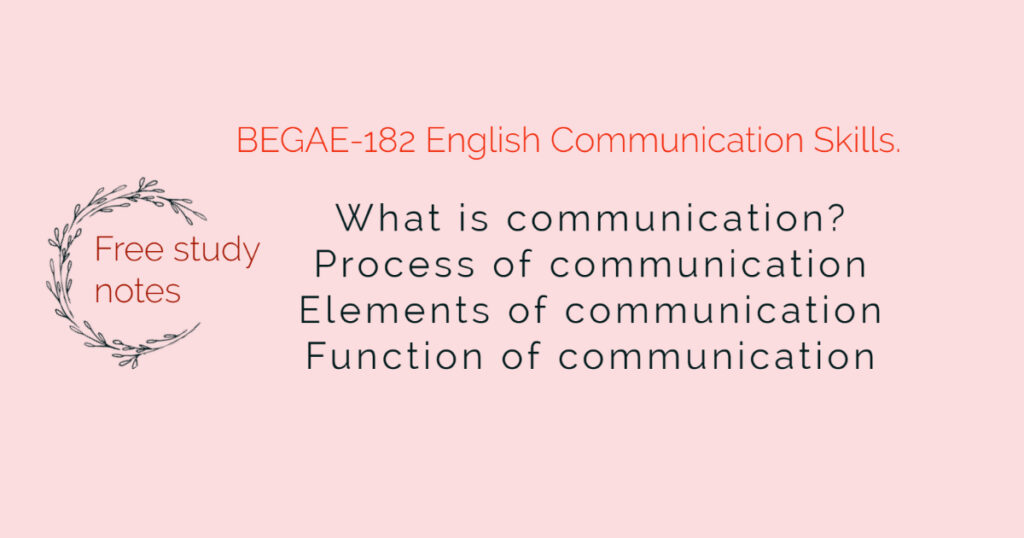This is a short note on IGNOU English course BEGAE- 182 English Communication Skills. This is a short and concise note anyone can follow without difficulty.
A Short Introduction to BEGAE-182
- Ability enhancement course for UG students.
- Emphasizes the development of four basic skills of communication.
- Listening.
- Speaking.
- Reading’.
- Writing.
Without these four skills, nobody can be an effective communicator in any language including English.
UNIT 01 THE PROCESS OF COMMUNICATION.
•Discuses the following topics:
- What is communication?
- Process of communication.
- Sources of communication.
- Barriers of communication.
- Differences between GD and other speech events.
What is communication?
- It is a process of exchanging ideas, information, and emotions from one person to another or from one place to another place.
- Mode of communication can be verbal or non-verbal.
- Verbal Communication- Communication without using words.
- Non-verbal communication- Communication Without using words. Facial expressions, body language, tone, signs, symbols, etc. are also included in the communication.
The process of communication.
- It is a continuous process.
- Communication is a Step by step action between sender and receiver or speaker and listener.
- The following elements contributed to the process of communication such as:
- Sender.
- Message.
- Encoding.
- Channel.
- Reciever.
- Decoding.
- Setting.
Elements of Communication
- Sender or Speaker.
- Sender is the one who generates or produces and conveys the message to the listener or receiver.
- Sender is the one who converts messages into codes.
- Sender has different names: encoder, writer, and speaker.
2. Message.
- message can be ideas, information, emotions, etc.
- It is generated or produced by the speaker.
3. Encoding
- Encoding is the process of converting ideas and information into different codes.
- words, pictures, signs, and symbols can be codes.
4. The Channel.
- A channel is a medium through which the message passes.
- A channel can be a letter, telephone, Email, etc
5. Receiver.
- The receiver is the one who decodes and receives the message and gives feedback for the message.
- The receiver has different names such as decoder and listener.
6. Decoding
- Decoding is the process of converting, words, pictures, or symbols into the form of information, ideas and emotions.
- The receiver is the one who decodes words, images, and symbols into the information, ideas and emotion.
- This is the reverse process of encoding.
7. The Setting.
- A setting is a physical and social context or situation.
- Speaker creates and transfers information and ideas based on the context or setting.
Functions of Communication.
There are seven basic functions of communication. Those are given below.
- Emotive Function: To express inner states and emotions: Eg:- to express happiness, sadness, surprise, anger, etc.
Wow! You got a perfect score on your English exam.
2. The Directive Function: To direct others to do something. Commonly found in command and request.
E.g. Close the door, please. Don’t smoke in this area.
3. The Phatic Function: To serve social Function, doesn’t offer valuable information
Uses to start a conversation, greet someone, or say Goodbye rather than for informative function.
E.g. Hello, Hai, How are you?
4. Poetic Function: poetic function means Aesthetic function- it means beautifying literary works by using rhythm, rhyme scheme, alliteration, repetition, etc.
5. The Referential Function: It is used to give new information and To describe a situation, object, or mental situation.
E.g. This is our new project, this is an expensive car.
6. The Metalinguistic Function: To explain or clarify some concept of the language itself.
Eg:- Grammar books and dictionaries perform the metalinguistic function.
BARRIERS TO COMMUNICATION
There are many barriers to communication. Let us discuss one by one
1. Code.
- Code means language.
- Language can be a barrier between the addresser (speaker) and the addressee (listener).
- The addressee may not know the language of the addresser.
- In such a situation, communication would not be successful.
2. The Language Differences
- Language variation also can be a barrier to communication.
- Variations or changes in pronunciation, intonation, accent, etc. also lead to confusion between sender and receiver.
3. Cultural Difference
- The meaning of words, signs, and symbols varies based on cultural differences.
- As a result, communication may not be successful when two people from different cultural backgrounds talk to each other.
4. Unfamiliar Concepts
- The unfamiliar concept also can be a barrier to effective communication.
- Technical terms and jargon words from a particular field may not understand by all people.
5. Lack of Background Information
- If we have sufficient background knowledge on any topic that helps us to understand very easily.
- At the same time, if we don’t have background knowledge, the topic may make any sense.
6. Affective factors
- Affective factors are also known as personal factors
- Anxiety, fear, attitude, lack of interest, and lack of motivation also can be communication barriers.
7. Physical environment
- Noise and other environmental disturbances and physical distance between addresser and addressee lead to poor communication.
TYPES OF COMMUNICATION
Communication can be categorized into three different groups.
| I. Communication– based on the expression | II. Communication– based on the flow of information | III. Communication– based on the relationship |
| Written, spoken, and gestural | Internal and external | Formal and informal |
I. TYPES OF COMMUNICATION- BASED ON EXPRESSION.
| Written communication | Oral communication | Gestural Communication |
| Written form Letters, circulars, reports, house journals, and magazines | Spoken form Telephone conversations, lectures, meetings | Communication by body language. E.g. Eye contact, head nodding, facial expression. |
II. TYPES OF COMMUNICATION- BASED ON THE FLOW OF INFORMATION
- Based on the flow of information communication has been divided into two types internal and external communication.
- In the case of internal communication, communication takes place within the organization, institution, or company.
- In the case of external communication, information passes to the outside company, agency, or institution
.

